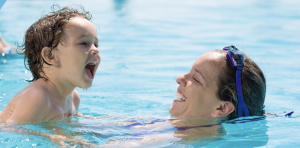June 28,2023- Emergency Medical Services Authority (EMSA) is encouraging families to take precautions to prevent drowning incidents ahead of Independence Day.
As temperatures begin to climb across Oklahoma, many families will beat the heat in a pool or at a local lake. However, EMSA medics warn that fun in the sun could take a dangerous turn in a matter of seconds.
“Things happen in an instant, in a blink of an eye,” said Andrew Watson, Clinical Services Specialist with EMSA.
According to the Centers for Disease Control and Prevention, drowning is the leading cause of death for children between the ages of 1 and 4 years old. It is also the second leading cause of unintentional injury death for children between the ages of 5 and 14 years old.
Last summer, EMSA responded to 29 drowning calls in its Oklahoma City service area.

Image Courtesy Centers for Disease Control and Prevention
In fact, there are an average of 11 drowning deaths per day in the United States.
“It’s referred to as the ‘silent killer’. Unlike what you see on TV or in the movies, drownings can happen without sound and in seconds,” said EMSA Chief of Public Affairs Adam Paluka. “It’s important to know the warning signs. Drowning is not a dramatic event involving splashing or someone screaming for help.”
With summer in full swing, EMSA paramedics stress that you should never let your guard down around a swimming pool.
“Even a strong swimmer can drown in any condition. Just because you say, ‘Hey, my kid knows how to swim’ doesn’t mean that they aren’t at risk to drown,” Watson said.
If you are spending time at the lake or a pool, EMSA officials say you need to know the signs of drowning.
“Some of the signs you’re going to see in the field, like when you’re watching someone in a pool or a lake, the person is going to be almost bobbing like a buoy versus what you would anticipate where they’d be kinda flat,” Watson said.
Watson says a person who is flat on the water is buoyant because they still have air in their lungs. However, someone who is drowning will be vertical and they likely won’t be screaming for help.
“It’s hard to scream and make a lot of noise when you don’t have air in your lungs. So they’re unable to call for help because they’re drowning,” Watson said.
EMSA encourages everyone to monitor for the following signs of drowning:
- A person’s head may be tilted back with their mouth open
- A person’s head may be low in the water with their mouth at water level
- The person’s eyes may be closed, glossy, or appear to be staring off into space
- A drowning person may be vertical in the water and appear to be trying to climb an invisible ladder.
“Someone whose struggling might be looking like that, but someone who’s truly drowning is not gonna be able to really alert you to the fact that they’re drowning so it’s going to be something that you have to look for. You’re not going to see them moving around as much. Their head is not gonna be a position where they’re able to breathe. They’re really just not gonna be able to alert you,” he added.
If you see someone drowning, EMSA officials say you need to act fast. Find something to throw to the patient to help pull them to safety as someone calls 911 for help.
“Use things to reach out to the person [who is drowning.] Jumping into the water should be your last resort,” he said, adding that jumping into the water can put yourself in danger.
EMSA also warns that just because your child is good swimmer or has floaties on does not mean they won’t drown.
“Any amount of water that will block an airway, a kid can drown,” Watson said.
EMSA medics say it is up to caregivers to pay close attention to children in pools or near bodies of water.
“It is crucial that we balance fun family time at the pool with awareness and diligence,” said Megan Bachman, founder of Oklahoma Swim Academy. “We want to educate parents on the value of survival swim lessons and having as many layers of protection as possible.”
“Make sure you keep an eye on your kids. It only takes a second,” Watson said.
If something does happen, EMSA medics say to call 911 immediately.
“Once the person is out of the pool, you want to look, listen and feel. Check to see if they are breathing and have a pulse. If not, start performing CPR while we’re on our way. You’re not gonna be doing it alone. EMSA dispatch will be walking you through it the entire time. They’re gonna stay with you,” he added.
Click here to watch a CPR demonstration by the American Heart Association.
